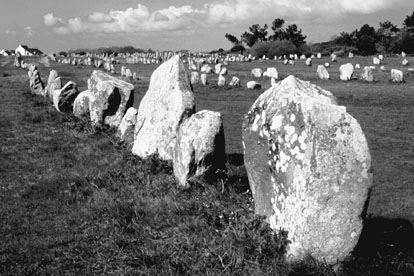

 | Page 528 |  |
Paleontology, where men like Raymond Vaufrey and Henri Vallois maintained the tradition, rather than helping to train the key professionals in an expanding discipline. From that time onward the choice was straightforward: between orthodoxy (superbly represented by the abbé breuil and françois bordes) or heterodoxy, inevitably shaped by the ideas of people who were self-taught. The institutional marginality and creativity of someone like André Leroi-Gourhan reaped their own reward in this setting.

Standing stones in Carnac, France
(Corel)
After Gabriel de Mortillet, André Leroi-Gourhan was undoubtedly the person who made the greatest contribution to shaping French prehistory. Like de Mortillet, he was self-taught and he brought the same passionate interest to understanding technical systems as the former did to defining the laws of evolution (Leroi-Gourhan 1943, 1945). By laying the foundations of comparative ethnography and drawing on anthropology and Orientalism, he established prehistory as a field in its own right. His approach to prehistory was completely different from the typologies of Breuil, which François Bordes later brilliantly developed and transformed (Bordes 1973). Whether with regard to the techniques of human labor, hominization, the interpretation of wall paintings, or excavation finds, the work of Leroi-Gourhan provided a frame of reference, an area of debate as vital for prehistoric archaeology as the work of Gordon Childe for protohistory. Against the disciplinary approach of traditional archaeology, which was primarily concerned with culture and classification, Leroi-Gourhan argued in favor of synthesis, combining anthropology and semiology in “prehistoric ethnology.”
Leroi-Gourhan’s approach—which had similarities with oriental archaeology—seemed well placed to win the day. But because it stayed deliberately marginal to both traditional prehistory and established ethnology, the work of Leroi-Gourhan was for a long time a matter of disappointment rather than development. It is important to realize that the questions raised by Leroi-Gourhan were discussed, then accepted or rejected. But the repercussions for archaeology
 |  |